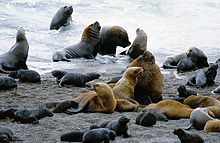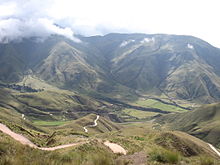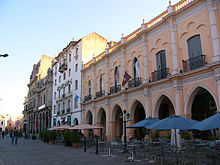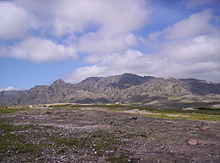Tourism in Argentina
The tourism in Argentina is today in many areas of the country one of the main branches of the services sector. It mainly takes place in areas near the coast and in the many different, attractive landscapes that make the country popular with visitors from abroad.
Unlike in many other emerging countries, tourism in Argentina had existed since the end of the 19th century, which was borne by the inhabitants of the country themselves. This has to do with the country's rich past and traditionally strong middle class, which still carries the majority of tourism today. Foreign tourism, on the other hand, is subject to fluctuations, which are mainly related to the exchange rate of the currency and the associated price level. In times of devaluations (especially 1987–1990 and after 2002) the influx of foreign tourists increased.
Characteristics
Most of the tourism in Argentina falls on the summer holidays, which are between mid-December and early March. The month of January is traditionally the month with the highest number of holidaymakers, because then the employees in the public services also have vacation and many authorities are closed or only work with few staff. The cities are often deserted at this time. A special feature is that many companies give their employees so-called quincenas (15-day periods) vacation; so each month is divided into two "quincenas". Additional vacation days are given in winter or near the public holidays.
The second season is the winter holidays (two to three weeks in July). During this time, due to the climate, the holiday areas more in the north are visited (e.g. Córdoba, Salta, Misiones), but the seaside resorts on the Atlantic also have some visitors at this time. A third season is Easter week (March / April), in which the highest total overnight stays are often recorded, as it is concentrated on four days. Furthermore, the long weekends with moving public holidays as well as the dates of various festivals (e.g. Carnival in the northwest and northeast, Oktoberfest in Villa General Belgrano , Pachamama festivals, the Día de la Primavera or the day of the student on September 21, etc. ) popular for short breaks.
A specialty is the Turismo estudiantil , the school trip tourism. Students usually take one trip each in 7th and 12th grade, which takes place in the off-season. By far the most popular destination is San Carlos de Bariloche , but Villa Carlos Paz and Mar del Plata are also popular. For these places, this type of tourism is attractive despite the relatively low student spending, as it allows the hotels to be fully booked all year round.
Major tourist areas
Tourism in Argentina is concentrated in relatively small, limited areas. The most important are the Atlantic coast of the province of Buenos Aires with its seaside resorts, the area around the Sierras de Córdoba in central Argentina and the Andes in Patagonia .
Atlantic coast of the province of Buenos Aires
The Atlantic coast of the province of Buenos Aires was the first tourist area worth mentioning in Argentina. The development began at the end of the 19th century in Mar del Plata , which is still the largest and most popular seaside resort in the country. Other places followed in the course of the 20th century. As a result of this development, the region now has an excellent infrastructure with a wide range of hotels and restaurants as well as a well-developed transport network (including motorway links to Buenos Aires). Around 4 million guests visit the region each year, with the locals in the majority; Most tourists come from the relatively close capital Buenos Aires and its suburbs . However, since the 1980s, the region has been facing increasing competition from beach resorts located to the south.
Popular tourist resorts in the region include Mar del Plata Necochea , Villa Gesell , Pinamar , Miramar and Atlántida Argentina , a continuous chain of seaside resorts at the mouth of the Río de la Plata , whose center is Santa Teresita . The focus is between the Atlántida and Mar del Plata, i.e. on the northern part of the coastal strip. The coast further south, on the other hand, is still determined by small seaside resorts such as Monte Hermoso , here there are still large undeveloped coastlines.
Sierras de Cordoba
The Sierras de Córdoba, an area of low mountain ranges up to 3,000 m altitude, rose to become the second most important tourist center in the country since the 1930s. The first hotel was opened in La Calera in the immediate vicinity of the city of Córdoba , other cities such as Río Ceballos followed suit. In the second half of the 20th century, however, the focus shifted to areas further away from the provincial capital, in particular Villa Carlos Paz , which is now the center of tourism in the region.
Besides Villa Carlos Paz Cosquín , La Falda , Villa Giardino , Santa Rosa de Calamuchita , Mina Clavero and Villa General Belgrano as well as numerous others are important places . There is also a national park, the Quebrada del Condorito National Park . Backpackers particularly visit the towns of San Marcos Sierras and Playa de los Hippies , two old hippie colonies.
Southern Andes
The southern Andes have been known as a tourist destination since the beginning of the 20th century. As early as 1922, the Parque Nacional del Sud was founded in the west of the Río Negro province near San Carlos de Bariloche , now known as the Nahuel Huapi National Park . Today the region, especially the city of Bariloche itself, as well as San Martín de los Andes is visited by around one million tourists a year. Another focus area is the area around the Los Glaciares National Park in the southern province of Santa Cruz , where the largest glaciers outside the polar regions can be visited. This area has been booming since the 1980s, with the tourist town of El Calafate growing from 3,000 inhabitants in 1991 to an estimated 18,000 in 2005. The test-tube town of El Chaltén , which was founded in 1988 and is now a center of the Mountaineering and trekking tourism is.
Misiones
The province of Misiones is an important tourist destination, especially because of the intact rainforests in places, but above all because of the Iguazú waterfalls , although the focus here is on short-term visitors. The area around the falls has a very large number of accommodation and gastronomy options and is also visited by many foreigners. Often round tours are offered which, in addition to the waterfalls, also include visits to the ruins of the Jesuit mission San Ignacio Miní .
Northwest Argentina

The north-west of the country has become another major tourist attraction in Argentina, especially in the past three decades. The tourist capital of the area is Salta with its famous colonial architecture. But also the old colonial cities of Iruya , Humahuaca , Purmamarca and Tilcara in the scenic Quebrada de Humahuaca gorge of the same name , as well as the places Cafayate , Cachi and Santa María del Yocavil in the Valle Calchaquí valley are visited by many domestic and foreign tourists. Northwest Argentina is considered to be the stronghold of backpacking tourism in Argentina, many young Argentinians and a large number of foreigners travel from there to Bolivia and Peru .
Patagonian Atlantic coast
The Patagonian Atlantic coast has also only been a tourist focus of the country for a few decades and is still experiencing a real boom. The most famous destination is the Valdés peninsula in the north of the Chubut province with a large variety of marine animals (sea lions, whales, penguins) and the neighboring Puerto Madryn , which is the starting point for tours on the peninsula and a seaside resort. The seaside resorts in this area are far apart; therefore the nature of the region as a whole still makes an intact impression, which is appreciated by more and more tourists. However, there are plans to build an asphalt coastal road, especially in Río Negro, and to set up holiday colonies along this route.
In addition to Puerto Madryn, the most important seaside resorts are Las Grutas in Río Negro, and Playa Unión and Rada Tilly in Chubut. All other coastal towns are still small and relatively insignificant, but are also growing steadily. Many have the advantage of being able to combine a beach holiday with a visit to the local wildlife, and the coasts of Patagonia with hills and cliffs are often more attractive than those of the province of Buenos Aires, in the Golfo San Matías the water and air temperature is even significantly higher than there .
Buenos Aires
The city of Buenos Aires is also a major tourist destination in the country, both by inland residents and by the foreigners who visit Argentina (around 80% of whom visit the city). It counts around a million visitors a year and has an excellent tourist infrastructure, also geared towards foreign visitors.
fire land
The island of Tierra del Fuego at the southern tip of Argentina is still an up-and-coming travel destination and there in particular the scenic surroundings of Ushuaia , the capital of the province of Tierra del Fuego and the southernmost major city in the world (only the small Puerto Williams in Chile is a little further south). There is also Argentina's southernmost national park, the Tierra del Fuego National Park , with a forest, moor and park landscape in the last foothills of the Andes.
Winter sports centers
There are several winter sports centers in the Andes. The focus is on the southern Andes. The following centers (from north to south) have an infrastructure for skiers:
- Los Penitentes in the province of Mendoza , in the immediate vicinity of the Aconcagua
- Las Leñas in the south of Mendoza, known as the most fashionable winter sports resort in Argentina
- Caviahue in the north of the province of Neuquén
- Ski park at Villa Pehuenia in the province of Neuquén
- Cerro Chapelco near San Martín de los Andes (Neuquén province)
- Cerro Catedral near San Carlos de Bariloche ( Province of Río Negro )
- Perito Moreno near El Bolsón (Río Negro Province)
- La Hoya near Esquel ( Chubut Province )
- Valdelén near Río Turbio ( Santa Cruz )
- Cerro Castor near Ushuaia ( Province of Tierra del Fuego )
Other travel destinations

Although almost all provinces try to attract tourism through targeted campaigns, there is hardly any real mass tourism in the country outside of the areas and places mentioned. Nevertheless, in almost all places today there is sufficient infrastructure for visitors with simple accommodation options.
The following places should be mentioned outside of the mentioned areas:
- Tolar Grande (Salta)
- Uspallata and Puente del Inca ( Aconcagua area) (Mendoza)
- El Barreal - San Juan Province
- Talampaya and Ischigualasto (provinces of San Juan and La Rioja)
- Chilecito and Sierra de Famatina (La Rioja Province)
- El Rodeo and Balcozna (Province of Catamarca)
- Escaba Reservoir (Tucumán)
- Villa Nougués / San Javier (Tucumán)
- Tafí del Valle / El Mollar reservoir / Amaicha del Valle / Quilmes (Tucumán)
- Sierras de San Luis (San Luis Province)
- Miramar / Mar Chiquita (Province of Cordoba)
- Villa Río Bermejito (Chaco Province)
- Empedrado (Corrientes Province)
Web links
- Official travel portal
- Embassy of the Republic of Argentina in Germany: Tourism
- Tourist Office of the Argentine Government
- Official Argentina portal of the Argentine government










